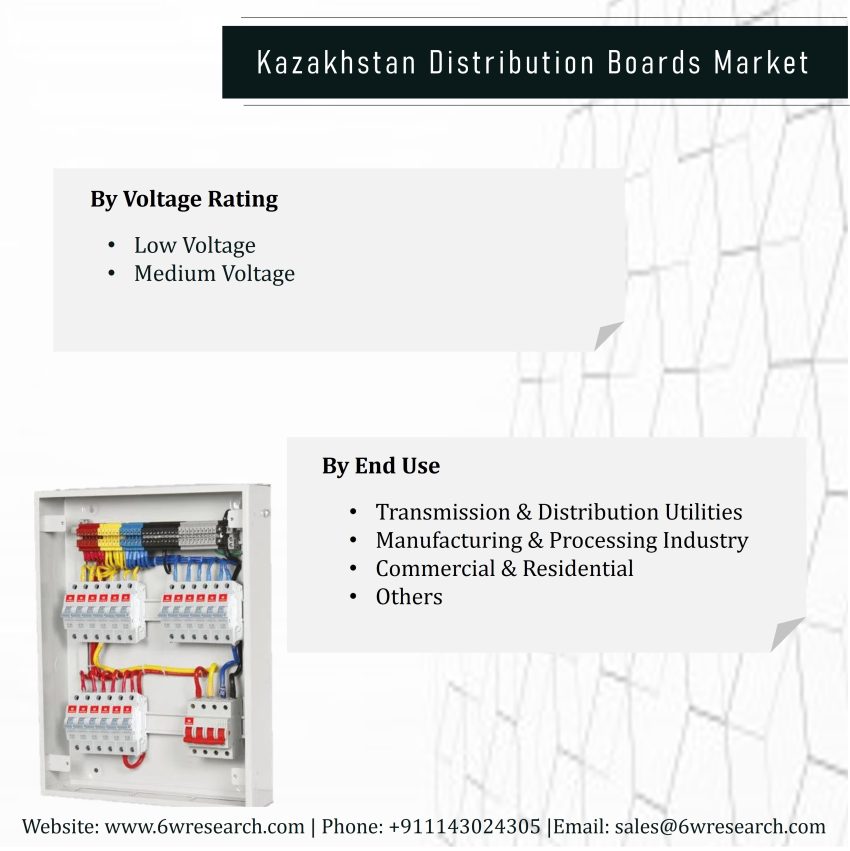Kazakhstan Distribution Boards Market Overview
The Kazakhstan distribution boards market is primarily driven by industrial, commercial, and residential construction. The country has a significant number of ongoing infrastructure projects, including the construction of new residential and commercial buildings, as well as upgrades to existing facilities. This has led to a high demand for distribution boards, as they are an essential component of any electrical infrastructure.
The market for distribution boards in Kazakhstan is expected to grow significantly in the coming years, driven by the increasing demand for electricity in the country. The government of Kazakhstan has made significant investments in the country’s power infrastructure to meet this growing demand. For instance, Kazakhstan’s Ministry of Energy has developed a plan to increase the country’s electricity production capacity by XX% by 2025, which will further drive demand for distribution boards.
The market for distribution boards in Kazakhstan is highly competitive, with a large number of local and international players operating in the market. Some of the key players in the market include Siemens AG, ABB Ltd., Schneider Electric SE, Legrand SA, and Eaton Corporation.
In conclusion, the distribution board market in Kazakhstan is expected to grow in the coming years, driven by the increasing demand for electricity and ongoing infrastructure projects. The market is highly competitive, with both local and international players operating in the market.
How are Distribution Boards Driving Market Growth in Kazakhstan?
Distribution boards play a critical role in electrical infrastructure, and their demand is directly related to the growth of the construction industry and the demand for electricity. In Kazakhstan, the distribution board market is being driven by the following factors:
- Construction of New Residential and Commercial Buildings: Kazakhstan has been experiencing rapid economic growth, leading to an increase in construction activity. This has resulted in the construction of new residential and commercial buildings, which require distribution boards as a critical component of their electrical infrastructure.
- Infrastructure Upgrades: Existing facilities require upgrades to meet the increasing demand for electricity. Upgrades require new distribution boards to be installed, which creates new demand for these products.
- Growing Demand for Electricity: The demand for electricity in Kazakhstan has been increasing, driven by the growth of industries, businesses, and the population. Distribution boards play a crucial role in the safe and reliable distribution of electricity, and as a result, the demand for these products has been increasing.
- Government Investments in Power Infrastructure: The government of Kazakhstan has been investing significantly in the country’s power infrastructure to meet the growing demand for electricity. This investment has led to the installation of new power plants and transmission lines, which require distribution boards as a key component of their electrical infrastructure.
- International Investments: Kazakhstan has been attracting significant international investments in various industries, which have led to the construction of new facilities. These facilities require distribution boards as a crucial part of their electrical infrastructure.
The demand for distribution boards in Kazakhstan is being driven by the growth of the construction industry, upgrades to existing facilities, increasing demand for electricity, government investments in power infrastructure, and international investments in various industries. These factors are expected to continue to drive market growth in the coming years.
Challenges Faced by Kazakhstan Distribution Boards Market
Despite the growing demand for Kazakhstan distribution boards market, there are several challenges faced by the market, including:
- Lack of Skilled Manpower: There is a shortage of skilled manpower in Kazakhstan, which has resulted in delays in the installation of electrical infrastructure, including distribution boards. This shortage of skilled manpower is also leading to safety concerns, as untrained workers may not be equipped to handle the installation and maintenance of distribution boards safely.
- Lack of Standardization: The lack of standardization in the design and installation of distribution boards has led to issues such as inconsistent quality and compatibility issues between different components. This can result in delays and additional costs for businesses that need to install or replace distribution boards.
- Price Sensitivity: Kazakhstan is a price-sensitive market, and the cost of distribution boards can be a significant factor in the purchasing decision. Low-cost alternatives from unverified suppliers can lead to poor quality and safety issues, making it challenging for established companies to compete.
- Import Dependence: The market for distribution boards in Kazakhstan is highly dependent on imports, with a significant proportion of distribution boards being imported from other countries. This dependence on imports can lead to supply chain disruptions and increased costs due to fluctuations in currency exchange rates and import tariffs.
- Inadequate Infrastructure: Despite government investments in power infrastructure, there are still areas of Kazakhstan that have inadequate power infrastructure, which can limit the market’s growth potential.
The challenges faced by the distribution board market in Kazakhstan include a shortage of skilled manpower, lack of standardization, price sensitivity, import dependence, and inadequate infrastructure. These challenges can impact the market’s growth potential and require careful consideration by businesses looking to operate in the market.
Kazakhstan Distribution Boards Market Size
The size of the Kazakhstan distribution boards industry was estimated to be worth around USD XX million. The market has been growing steadily in recent years, driven by the increasing demand for electricity in the country and ongoing infrastructure projects.
The market is highly competitive, with both local and international players operating in the market. Some of the key players in the market include Siemens AG, ABB Ltd., Schneider Electric SE, Legrand SA, and Eaton Corporation.
The demand for distribution boards in Kazakhstan is expected to continue to grow in the coming years, driven by the increasing demand for electricity and ongoing infrastructure projects. The government of Kazakhstan has made significant investments in the country’s power infrastructure to meet this growing demand. For instance, Kazakhstan’s Ministry of Energy has developed a plan to increase the country’s electricity production capacity by XX% by 2025, which will further drive demand for distribution boards.
In conclusion, the distribution board market in Kazakhstan is relatively small compared to other markets in the region, but it is expected to grow in the coming years. The market is highly competitive, and businesses operating in the market will need to carefully consider the challenges and opportunities presented by the market to succeed.
Conclusion of the Kazakhstan Distribution Boards Market
In conclusion, the Kazakhstan distribution board market is experiencing growth due to the increasing demand for electricity, ongoing infrastructure projects, and government investments in the country’s power infrastructure. The market faces challenges such as a shortage of skilled manpower, lack of standardization, price sensitivity, import dependence, and inadequate infrastructure.
However, the market presents opportunities for both local and international businesses, with a highly competitive landscape and a growing demand for distribution boards. To succeed in the market, businesses will need to carefully consider the challenges and opportunities presented by the market and develop strategies to meet the needs of the market.
Overall, the distribution board market in Kazakhstan is expected to continue to grow in the coming years, driven by the ongoing demand for electricity and infrastructure development in the country.

